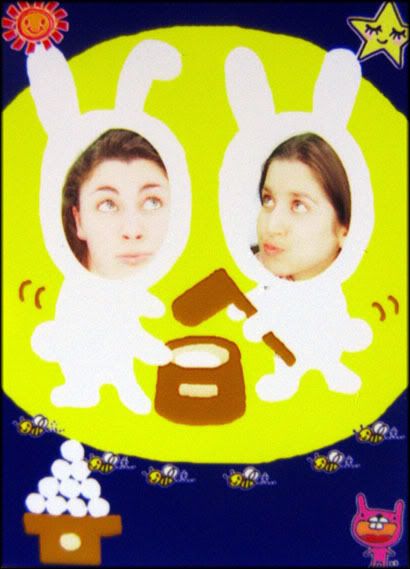
A little seasonal purikura for your moon-viewing enjoyment. Notice the NOVA rabbit in the lower right-hand corner gazing wistfully at the moon, as if longing to return home after ripping-off unsuspecting Japanese and gaijin alike, getting caught, and going bankrupt.
 I'm sure that anyone interested in Japanese culture has noticed the prevalence of rabbits and moons in both popular and traditional culture. They're everywhere, from anime (Sailor Moon's Tsukino Usagi, which can be translated as 'Moon Rabbit') to traditonal sweets. Japanese people will happily point to the legend of the mochi-making rabbitt on the moon as the origin of their cultural obsession, even though most of them will readily admit that they've never been able to see it. (Perhaps the image at the right will give you the upper hand!)
I'm sure that anyone interested in Japanese culture has noticed the prevalence of rabbits and moons in both popular and traditional culture. They're everywhere, from anime (Sailor Moon's Tsukino Usagi, which can be translated as 'Moon Rabbit') to traditonal sweets. Japanese people will happily point to the legend of the mochi-making rabbitt on the moon as the origin of their cultural obsession, even though most of them will readily admit that they've never been able to see it. (Perhaps the image at the right will give you the upper hand!)Japan is not alone in its moon-rabbit maddness, which seems to have spread through Asia with the advent of Buddhism. Originating in India, the legend struck a chord in certain cultures, slowly shaping itself in the image of each as it spread to China before ultimately being transmitted to Japan. The custom of moon-viewing itself has roots in China's traditional mind-autumn celebration, when the people treated themselves to moon cakes, but when the custom was transmitted to Japan, mochi ( sweet, pounded rice cakes) quickly took their place. The Chinese believed the rabbit in the moon was busy mixing the Elixer of Immortality, a reflection of the long history and influence of Chinese medicine. In Japan, where no such tradition existed, they envisioned a rabbit making mochi much as they did-- pounding it with mallets until is reached its smooth, sticky perfection. This process, called mochitsuki (餅つき), lent itself nicely to a clever play on words, which can also mean full moon (望月).
 "Moon Rabbit" mochi
"Moon Rabbit" mochiThe story goes that in a previous existences as a boddhisattva, Shakyamuni (the Buddha) taught his followers about a wise rabbit who lived in a forest with three of his friends: the monkey, the fox, and the otter. The reincarnation of a bodhisattva himself, the rabbit posessed a wisdom that would surely lead him to enlightenment. In the afternoon, the friends went about their buisness alone, but in the evenings they gathered together to hear the rabbit speak about life and morality. On the day of the full moon, the rabbit proposed that instead of eating alone, they gather their food together and distribute it among the hungry. His three friends agreed.
 Sugary tsukimi wagashi, Japanese sweets shaped as bunnies, tsukimi dango moon-viewing rice dumplings), chestnuts, mushrooms, fall flowers and of course, the full moon veiled in pampass grass.
Sugary tsukimi wagashi, Japanese sweets shaped as bunnies, tsukimi dango moon-viewing rice dumplings), chestnuts, mushrooms, fall flowers and of course, the full moon veiled in pampass grass.The monkey climbed trees to gather mangos, the fox gathered the leftovers the workers had left in their feilds, and the otter caught fish in the river. Since the rabbit ate grass, he didn't really have to go out of his way to get food, but he knew that no human would want to eat grass. "If someone hungry comes to beg for food, I will offer them my body. I'm sure lots of people would like to eat rabbit meat!" Then he told everyone what he decided.

Hearing this, the King of Heaven was suprised. To test their sincerity, he disguised himself as a lowly beggar and visited each of them, pleading for food. The monkey, the fox and the otter all happily offered not only part of their foods, but all they had gathered. Pleased, he went to the rabbit. "Might you have some food for a poor beggar?" He asked.
"I understand," the rabbit said. 'I'll give you something delicious. Please, make a fire." With his supernatural powers, the King of Heaven made a roaring fire right before his eyes. The rabbit immediately jumped in, but it was not hot. "You're fire is powerful, but it's not even hot enough to singe a single strand of my hair!" he exclaimed.
"You know, wise man, I am no beggar. I came down from heaven to test the sincerity of your words. Doing good deeds is very important. You're deeds will not be forgotten." Wringing the mountain, he used its ink to paint the shape of a rabbit on the moon, a memorial to the rabbit's goodness for all generations.














